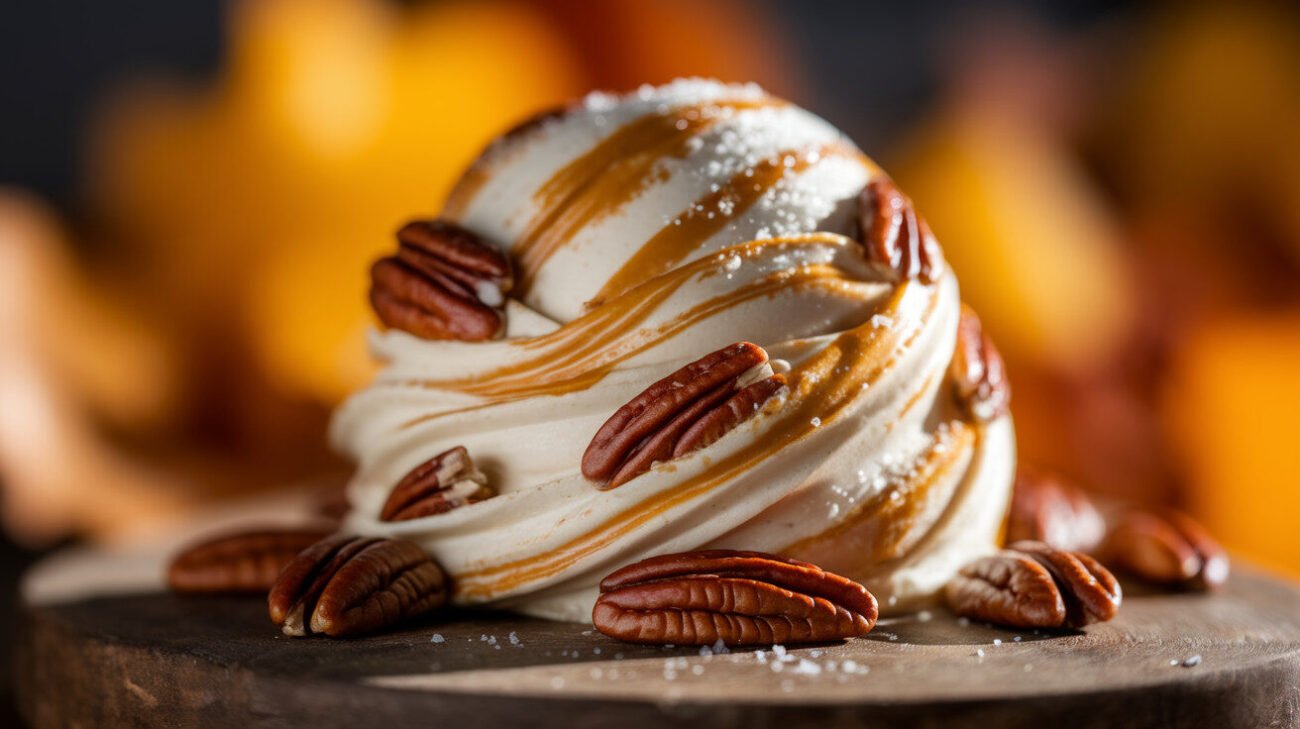This Salted Caramel Pecan Keto Ice Cream represents what I consider the ultimate achievement in low-carb frozen desserts—something actually scoopable straight from the freezer. Let’s be honest—most homemade keto ice cream is disappointing. It’s either rock-hard or has that weird, icy crystallization that makes you wonder why you bothered. After developing and testing over fifty variations in my professional kitchen, I’ve cracked the code for creating scoopable, creamy keto ice cream that actually satisfies like the real thing.
The Quest for Scoopable Keto Ice Cream
The fundamental problem with sugar-free ice cream comes down to freezing point depression. Sugar doesn’t just sweeten conventional ice cream—it lowers the freezing point so the dessert remains scoopable straight from the freezer. Without it, water molecules form large ice crystals, and fat molecules clump together into unpleasant greasy chunks. It’s a texture disaster.
Why Most Homemade Keto Ice Cream Fails
I’ve analyzed countless failed attempts from my readers, and the issues consistently fall into three categories. First, inadequate sweetener selection—many recipes rely solely on erythritol, which recrystallizes and creates cooling effects while providing insufficient freezing point depression. Second, improper fat balance—too much and it’s greasy, too little and it’s icy. Third, technical execution errors during the churning and freezing process that compromise the emulsion.
The frustration is real. You invest in expensive ingredients, follow a recipe that promises “just like real ice cream!” and end up with something that either requires 20 minutes on the counter to soften or has the texture of flavored ice chips. This is why I’ve moved beyond simple formula replication to understanding the food science behind what makes frozen desserts work.
The Science Behind Scoopable Low-Carb Frozen Desserts
The breakthrough came when I started applying professional ice cream science principles to keto formulations. The key is creating what’s called a “glass transition state” where the mixture becomes amorphous rather than crystalline when frozen. This requires three components working together: the right sweetener blend for freezing point depression, sufficient solids for structure, and proper emulsification for smoothness.
What most home cooks don’t realize is that commercial keto ice creams use stabilizers like guar gum and xanthan gum not as “cheats” but as necessary components for texture. In our homemade version, we’re using egg yolks as both emulsifier and stabilizer—the lecithin in yolks creates a stable fat-in-water emulsion that prevents ice crystal formation. The protein content adds solids that further improve texture.
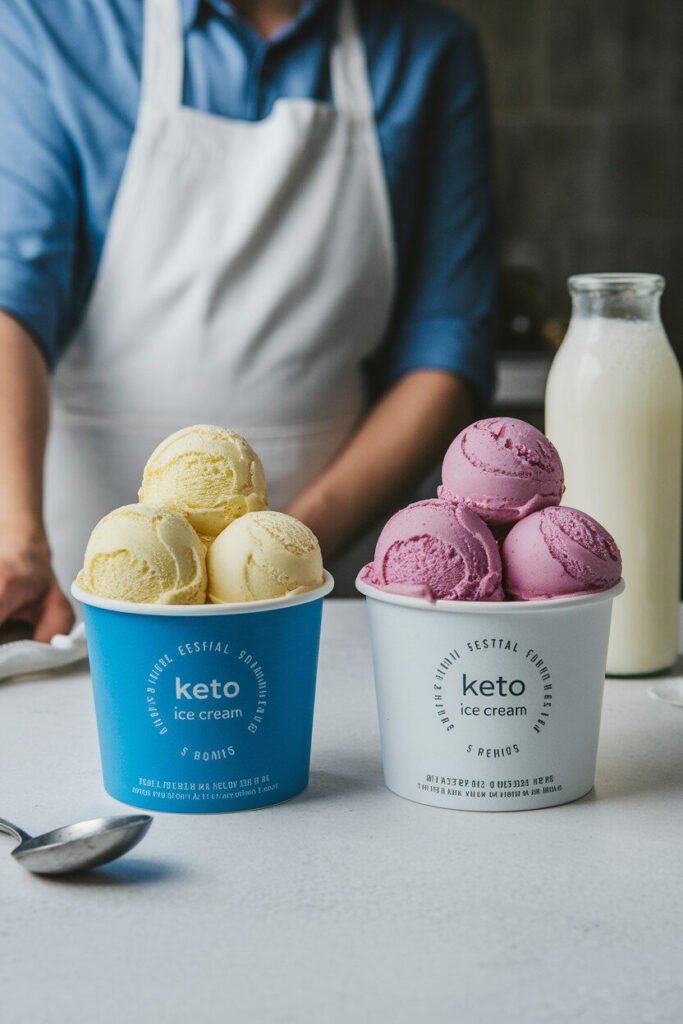
Mastering the Keto Ice Cream Base & Caramel Swirl
Selecting Your Sweeteners for Flavor and Texture
After extensive side-by-side testing, I’ve landed on a three-sweetener blend that mimics sugar’s functional properties without spiking blood glucose. Allulose is the star here—it provides approximately 70% of the freezing point depression of sucrose without the cooling effect or digestive issues some experience with sugar alcohols. We’re supplementing with erythritol for bulk and a small amount of monk fruit for clean sweetness without aftertaste.
The ratios matter tremendously. Too much allulose and the ice cream becomes overly soft; too little and it’s brick-hard. For every cup of base liquid, I use ⅓ cup allulose, 2 tablespoons erythritol, and ¼ teaspoon monk fruit extract. This creates the ideal -3°C (27°F) serving temperature that gives you that perfect scoopable texture directly from the freezer.
Crafting the Perfect Sugar-Free Salted Caramel
The caramel sauce makes or breaks this recipe. Traditional caramelization requires sugar, but we can achieve remarkably similar flavor through careful cooking technique. The secret lies in using allulose as your primary sweetener—it undergoes Maillard browning similarly to sucrose, unlike erythritol which simply melts.
You’ll need:
- ½ cup allulose
- ¼ cup heavy cream
- 3 tablespoons butter
- ½ teaspoon vanilla extract
- ¾ teaspoon sea salt
Method: Melt the allulose in a heavy-bottomed saucepan over medium heat. Don’t stir—just swirl the pan occasionally. It will liquefy and gradually darken to an amber color. This takes 5-7 minutes—be patient. Remove from heat and immediately whisk in the butter until incorporated (it will bubble vigorously), then slowly stream in the cream while whisking constantly. Return to low heat if the caramel seizes and whisk until smooth. Off heat, stir in vanilla and salt. Cool completely before using.
Preparing Toasted Pecans for Maximum Flavor
Raw pecans simply won’t deliver the depth this recipe deserves. Toasting is non-negotiable—it develops the volatile compounds that give pecans their characteristic buttery, rich flavor. Spread ¾ cup pecan halves on a baking sheet and toast at 350°F (175°C) for 6-8 minutes until fragrant. Watch carefully—they burn easily. Cool completely, then chop roughly so you get varied texture throughout the ice cream.
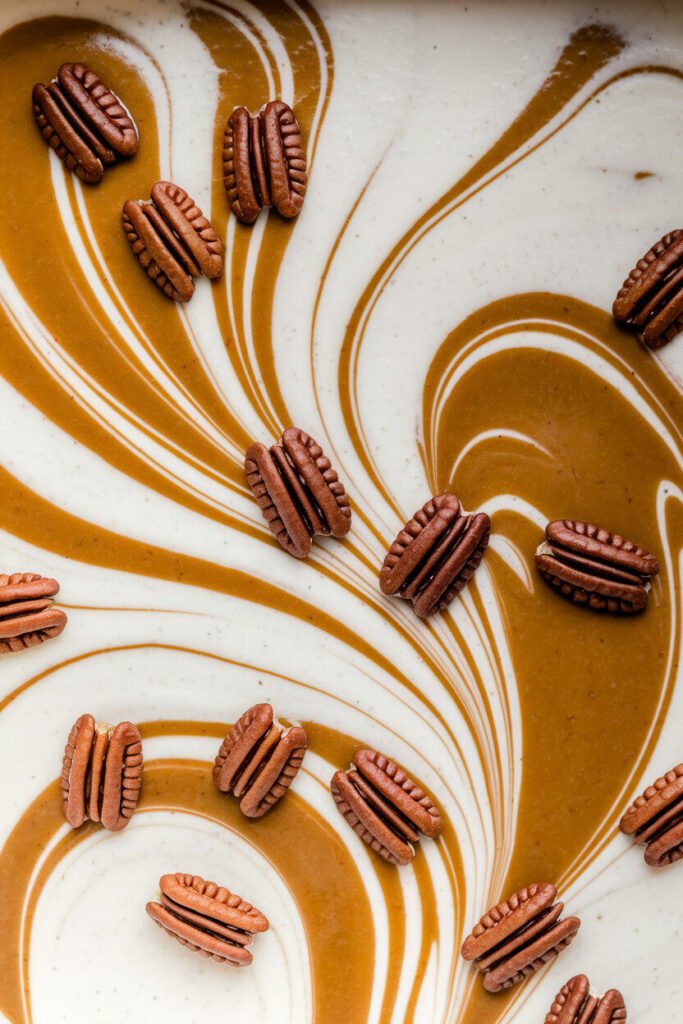
Step-by-Step Recipe: Salted Caramel Pecan Keto Ice Cream
Ingredients for the Ice Cream Base:
- 2 cups heavy cream
- 1 cup unsweetened almond milk
- 6 large egg yolks
- ⅓ cup allulose
- 2 tablespoons erythritol
- ¼ teaspoon monk fruit extract
- 1 teaspoon vanilla extract
- ¼ teaspoon xanthan gum (optional, but improves texture)
- 1 batch sugar-free salted caramel (recipe above)
- ¾ cup toasted chopped pecans
Creating the Ultra-Smooth Base
The custard method (egg-based) produces significantly superior results to Philadelphia-style (egg-free) for keto ice cream. The eggs provide emulsification and richness that prevent iciness. Begin by whisking the egg yolks, allulose, erythritol, and monk fruit extract until pale and slightly thickened—about 2 minutes with a hand mixer.
Meanwhile, heat the heavy cream and almond milk in a saucepan until just steaming (around 175°F/79°C)—don’t boil. Temper the egg mixture by slowly pouring about 1 cup of the hot cream into the yolks while whisking constantly. Then return everything to the saucepan and cook over medium-low heat, stirring constantly with a spatula, until the mixture thickens enough to coat the back of a spoon (around 180°F/82°C).
Strain through a fine-mesh sieve to remove any cooked egg bits—this step is crucial for perfectly smooth texture. Whisk in vanilla and xanthan gum (if using). Cool completely, then refrigerate for at least 4 hours or preferably overnight. This aging process allows the proteins to fully hydrate and results in better texture.
Churning and Layering Techniques
Churn the chilled base in your ice cream maker according to manufacturer’s directions. During the last 5 minutes of churning, add the toasted pecans. Now for the layering: spread one-third of the churned ice cream in your storage container, drizzle with one-third of the caramel sauce, repeat twice more. Use a knife to gently swirl—don’t overmix or you’ll lose the distinct caramel ribbons.
The container matters more than you might think. I use shallow rectangular containers rather than deep tubs—the increased surface area allows for more even freezing and easier scooping. Stainless steel conducts temperature better than plastic, but any airtight container will work.
The Perfect Freeze for Scoopable Consistency
This is where most people go wrong. You need to freeze rapidly to prevent large ice crystals from forming. Place your container in the coldest part of your freezer (usually the back bottom) and avoid opening the door frequently during the initial freeze. The ice cream will be ready in 4-6 hours, but for ideal texture, let it cure for 24 hours before serving.
If your freezer has a “quick freeze” function, use it. The faster the freeze, the smaller the ice crystals, and the creamier the final product. I’ve measured the difference with a laser thermometer—slower freezing can result in crystals up to three times larger than rapid freezing.
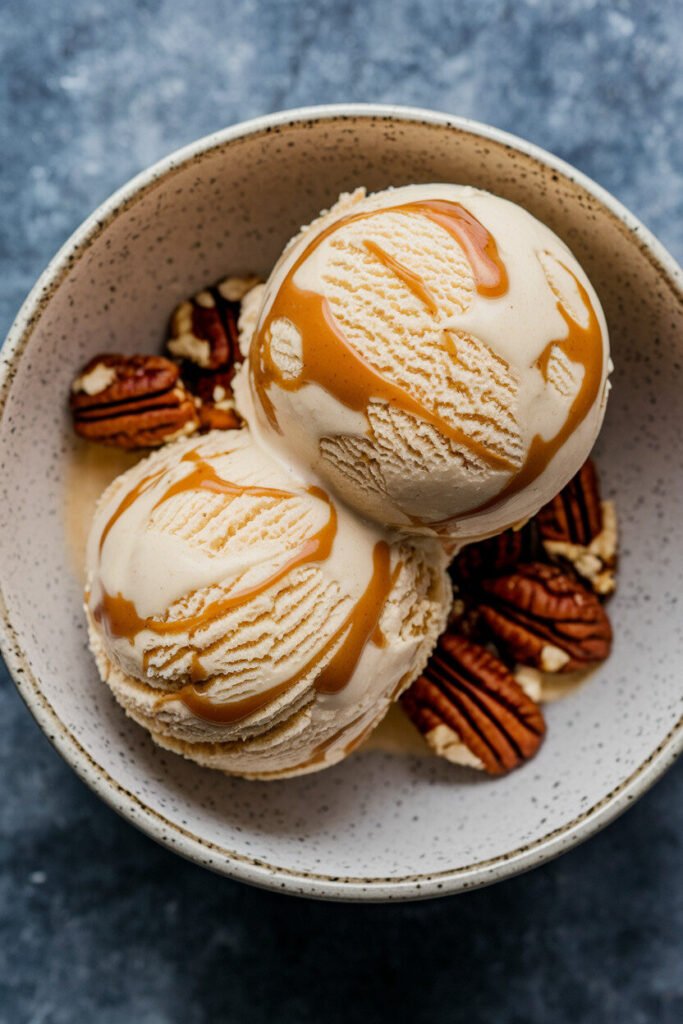
Storage, Serving, and Customization
Proper Storage to Maintain Perfect Texture
Keto ice cream has a shorter optimal texture window than conventional ice cream—about 3-4 weeks maximum. The allulose continues to absorb moisture over time, eventually making the texture too soft. For best results, press parchment paper directly onto the surface before sealing to prevent ice crystal formation from air exposure.
If your ice cream becomes too hard (usually from temperature fluctuations), let it sit at room temperature for 8-10 minutes before scooping. Don’t microwave it—the uneven heating will compromise the emulsion. I’ve found that the ideal serving temperature is around 8-10°F (-13 to -12°C) for keto ice cream versus 6-8°F (-14 to -13°C) for conventional.
Serving Suggestions and Topping Ideas
While delicious alone, this ice cream welcomes complementary flavors. A drizzle of extra salted caramel sauce (gently warmed) contrasts beautifully with the cold ice cream. For chocolate lovers, a sugar-free dark chocolate shell made with cocoa powder, coconut oil, and sweetener adds textural interest.
For those wanting to enhance the keto aspects, a sprinkle of flaky sea salt just before serving heightens the caramel notes. Crumbled keto shortbread cookies can add crunch without compromising macros. I sometimes add a pinch of cinnamon to the base for a subtle flavor variation that pairs wonderfully with the pecans.




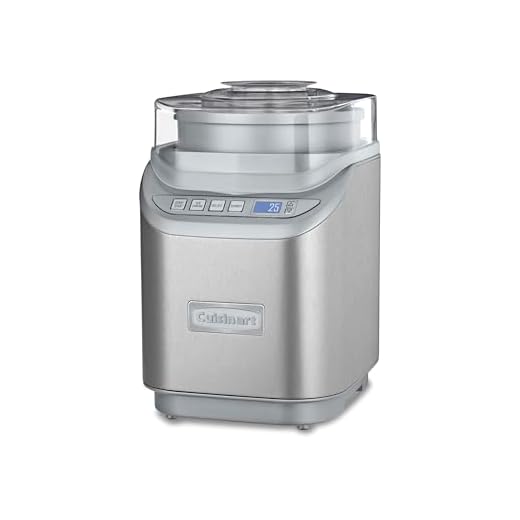
Frequently Asked Questions
Why is my keto ice cream rock hard?
This is almost always a sweetener ratio issue. If you substituted the allulose with more erythritol, you’ve lost the freezing point depression. Allulose is non-negotiable for scoopability. The second most common cause is insufficient fat content—don’t reduce the heavy cream.
Can I make this recipe without an ice cream maker?
You can, but the texture will be less smooth. Pour the chilled base into a shallow pan, freeze until solid around the edges, then transfer to a bowl and beat with an electric mixer to break up ice crystals. Repeat every 30 minutes for 2-3 hours, then fold in additions and freeze completely.
What’s the best sugar-free sweetener for ice cream?
For functionality, allulose is superior because it doesn’t recrystallize and provides excellent freezing point depression. For taste, I prefer the blend in this recipe—allulose for texture, erythritol for bulk, monk fruit for clean sweetness without aftertaste.
How can I reduce the carb count further?
You could reduce the pecans by half, though you’ll sacrifice texture and flavor. The base itself is already optimized for low carbs—most of the carbohydrates come from the dairy, which is necessary for structure.
Can I use different nuts in this recipe?
Walnuts make a good substitution, though they have a stronger flavor that might overpower the caramel. Macadamia nuts work beautifully if you want to increase the fat content. Avoid almonds unless toasted—they can become unpleasantly hard when frozen.
How long does homemade keto ice cream last?
At peak texture, 3-4 weeks. It remains safe to eat indefinitely while frozen, but the quality deteriorates after a month as the emulsion slowly breaks down and ice crystals enlarge.
Is this ice cream dairy-free?
No, the heavy cream and butter are essential for texture. For dairy-free, I’d recommend a different recipe entirely based on coconut cream and refined coconut oil—the flavor profile would need significant adjustment to complement the caramel. For those interested in the science behind allulose’s unique properties, the FDA’s review of allulose provides useful information about its regulatory status and characteristics.
This Salted Caramel Pecan Keto Ice Cream achieves what many think impossible—genuinely scoopable low-carb ice cream with deep, balanced flavors that stand up to conventional versions. The technique matters as much as the ingredients, so follow each step precisely for that perfect texture straight from the freezer.
